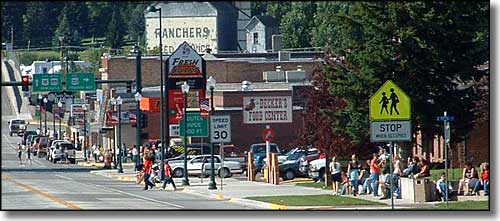
Lusk, Wyoming

Waiting for a parade in downtown Lusk
The county seat of Niobrara County on the plains of eastern Wyoming, Lusk was first platted in July of 1886. It was named in honor of a prominent Wyoming railroad contractor and rancher, Frank Lusk (who also happened to be the local railroad representative and owned the land). Gold, silver and copper were mined just west of the new town site and it was the coming of the Fremont, Elkhorn & Missouri Valley Railroad that started the boom town of Lusk. Just west of the mine site was a tent colony named Silver Cliff. 40 lots in Lusk went up for sale at auction on Tuesday, July 20, 1886 and by the following Saturday, the entire tent colony had moved to Lusk. In that first week, a livery stable, a 25x50 hardware store, a bank, a train depot, 7 saloons, a newspaper office and several other buildings were constructed. A week after that a lumber office and yard, 2 drug stores, 2 meat markets, a grocery, 2 dry goods stores, 2 more hardware stores, 2 doctor's offices, 2 barber shops, a post office, 4 restaurants, 2 furniture stores, a lodging house and a wholesale liquor dealer were added to the town's inventory of businesses and buildings. Then on August 1, 1886, it was almost completely wiped out by wind, rain and hail that swept in from the northwest and wreaked terrible damage on the town. People started rebuilding the next day.
In 1901 the city installed a drinkable water system. The first telephones arrived a couple years later. When Niobrara County was formed in January 1913, as the biggest town in the county Lusk was named the county seat. The voters approved a sale of bonds for electricity in 1914 and the city's electric power plant flipped the "on" switch in 1919.
Back in the 1870's there was a local woman who'd been named "Mother Featherlegs" (because of her red pantalets that resembled feathers flapping in the wind when she rode horseback). She and a fellow named Dangerous Dick Davis ran a saloon and brothel out of their cabin to the southwest of where Lusk would soon be. This was along a somewhat dangerous section of the Cheyenne-Deadwood Stage Route and their place was a favorite hangout for folks on the wrong side of the law. In 1879 she was found near her spring, shot dead, and Dangerous Dick had disappeared. She was rumored to have a bunch of money stashed but no one has found it yet... There is a historic marker near the site of her cabin these days. Her pantalets, though, their story still goes on. They were stolen from the historic cabin in 1964 and ended up on display in a Deadwood saloon until a group of determined residents from Lusk went there and retrieved them in 1990.
In 1917 there was a boom in population when oil drillers hit the Buck Creek Dome near Lance Creek and housing became a serious problem. By 1919 there were 10 new hotels and rooming houses, 2 new banks, a new train depot, a new courthouse, a new steam laundry, several new restaurants, 2 new hardware stores, 9 new business buildings and a new Carnegie Library built in Lusk. There was even a new oil refinery under construction. The population peaked in 1920 at more than 10,000. Then the oil boom was over and things dropped off again.
Today, Lusk is a quiet and peaceful town at the southwestern edge of the Black Hills. Agriculture and tourism are the big businesses in town now, although the Wyoming Women's Center has been built just outside of town...
Latitude: 42.7607°N
Longitude: 104.4527°W
Founded: 1886
Elevation: 5,020'
Education:
High School or Higher: 85.9%
Bachelor's Degree or Higher: 14.8%
Graduate or Professional Degree: 2.5%
2011 Cost of Living Index for Lusk: 79.3
Median Resident Age: 41.7 Years
Estimated Median Household Income: $42,650
Estimated Median Home Value: $110,400
Population Density: 706 People per Square Mile
Major Industries:
Agriculture, Educational Services, Lodging & Food Services, Construction, Government, Health Care, Truck Transportation, Rail Transportation, Social Services
Unemployed (March 2011): 5.1%
Population Demographics: 2010
| Total Population | 1,567 |
| Males | 661 |
| Females | 906 |
| Population by Age | |
| Under 18 | 286 |
| 18 & over | 1,281 |
| 20-24 | 85 |
| 25-34 | 212 |
| 35-49 | 322 |
| 50-64 | 344 |
| 65 & over | 293 |
| Population by Ethnicity | |
| Hispanic or Latino | 39 |
| Non Hispanic or Latino | 1,528 |
| Population by Race | |
| White | 1,499 |
| African-American | 4 |
| Asian | 9 |
| Native American | 17 |
| Hawaiian or Pacific Islander | 0 |
| Other | 9 |
| Two or more | 29 |
